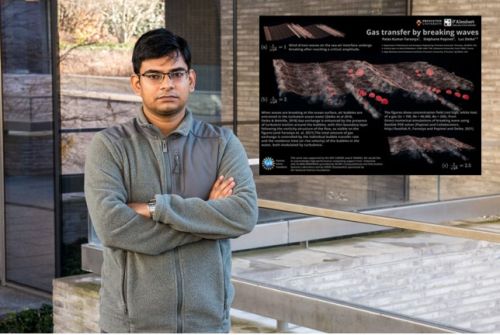
Palas Kumar Farsoiya: On Gas Transfer from Breaking Waves and Bubbles
It is safe to say that just about everyone loves bubbles. As children we delighted in blowing soap bubbles and watching them float through the air until bursting. As adults, champagne bubbles certainly captivate our senses with their hypnotic dance of popping in the golden liquid, a process also known as perlage. Bubbles, proving yet more versatile, even drifted into literature. In Shakespeare’s, Richard III, Queen Margaret speaks, symbolically of course, during her monologue as she says, “…a dream of what thou wast…a breath, a bubble” (4.4.88-89). But, for Palas Kumar Farsoiya, Postdoctoral Research Associate in the Mechanical and Aerospace Engineering Department at Princeton University, his reasons for studying bubbles were not so much because of the weightless presence, but rather due to the gas transfer applications.
More specifically, Palas researches the gas transfer from breaking waves and bubbles with regard to ocean-air interactions. As a trained chemical engineer, he has studied mass transfer operations thoroughly, and it has given him an advantage in his analyses. He explains, “This molecular phenomenon is not visible to the eye and it is really fascinating to bring it forward using simulations.” Palas did just that in poster form and it resulted in being chosen as the 2021 Milton Dyke Award recipient for Gallery of Fluid Motion. His poster vividly demonstrates breaking waves with colorless gas dissolving into and off of ocean water. His computer simulations also depict bubbles in turbulent flow, gas transfer from bubbles in turbulent flow, gas transfer from breaking waves and film breakup of surfaces bubbles.
Palas is currently working on two research projects; Inhouse and Open Source. Inhouse is a two-phase solver of volume of fluid (VoF) based on Navier-Stokes solver for 2D cartesian and axisymmetric coordination systems. He says, “The project involves providing a predictive model of gas transfer from breaking waves and bubbles. Turbulent flows in one phase are still being investigated by the scientific community, and with two phases the complexity increases.” The Open Source project, is a solver of Mass transfer and phase change models developed for direct simulation (DNS) of two-phase flows. Palas says of the plan based on Basilisk by professor Stéphane Popinet (Sorbonne Université) and collaborators, “I am adding the capability to simulate gas transfer and phase change in that project. It is helping us to investigate problems of gas transfer and evaporation on ocean-air interface.” The long-term goal for these programs is to “improve the large-scale models that can predict climate in the future that will help policymakers in mitigating adverse climate,” Palas explains.
Before venturing into a career as a scientist, Palas had a prestigious position as a Senior Production Executive at SRF, Ltd in India. He was managing human resources for 14 junior engineers and 40 technicians in a chemical production plant. However, the job was not fulfilling his desire for science and engineering and he decided to take the leap of pursuing his dream by first leaving his job and then entering the Indian Institute of Technology (ITT).
It was during his time at ITT that he discovered his love for teaching. Having already built on a strong background in training while at SRF, Ltd, teaching was a natural progression because of his ability to breakdown complex information and students also responded well to him.
Palas has an extensive roster of conference experience and journal publications. He is a skilled collaborator, in part, because he has been perfecting the ability since childhood. As a young boy, his family moved every three years due to his father being in the Army. Although it was difficult for Palas to say goodbye to friends when leaving a place that had been home for a short time, it also instilled communication skills that allowed him to make new friends quickly. By the time he was an adult, he was a skilled collaborator. In fact, when he met professor Stephane Popinet in Denver in 2017, they worked together to resolve “issues I was facing in numerical tools for the wave study in my doctoral research,” he explains. And in 2018, while in Vienna, he met professor El Hinch whom he partnered with on a theory regarding viscous waves.
Not surprisingly, with the number of times Palas and his family moved, they are very close. He credits his family, specifically his parents, with providing him the support he needed while studying for his Masters and Doctorate.
Life has certainly changed for Palas since coming to Princeton University. Working as a Postdoctoral Research Associate is extremely rewarding, especially since his future plans are a career as a professor. He is also a new father to daughter Meghana, 8 months. “Fatherhood has made me more patient now. I’m less anxious than before she was born. I can also tolerate a lot of crying now. She cried a lot in the beginning,” he says with a laugh, relieved that that stage is behind him now.
-- Verna Fisher